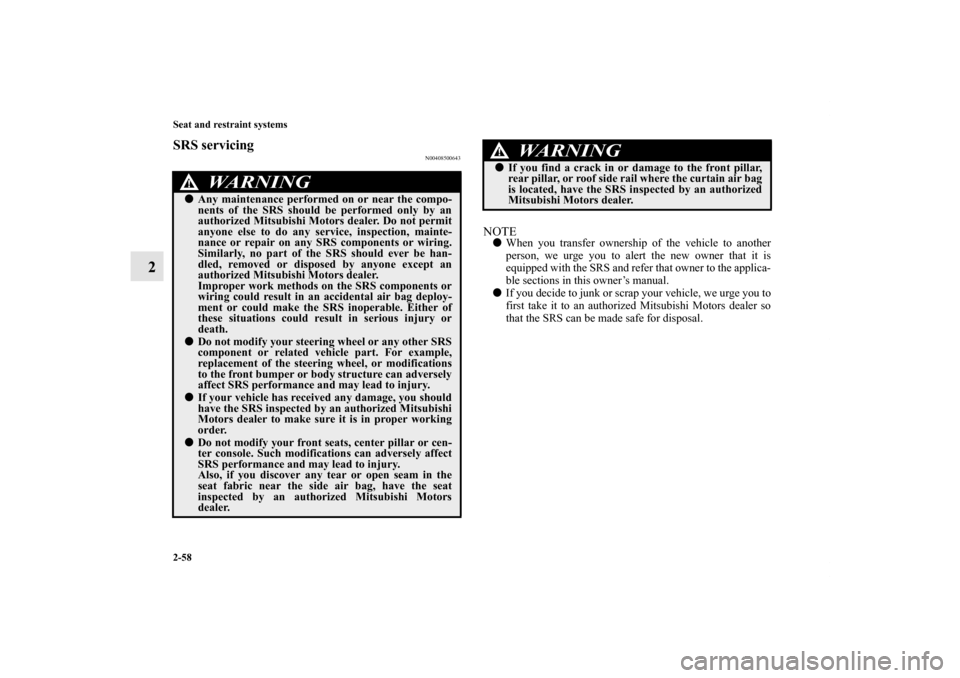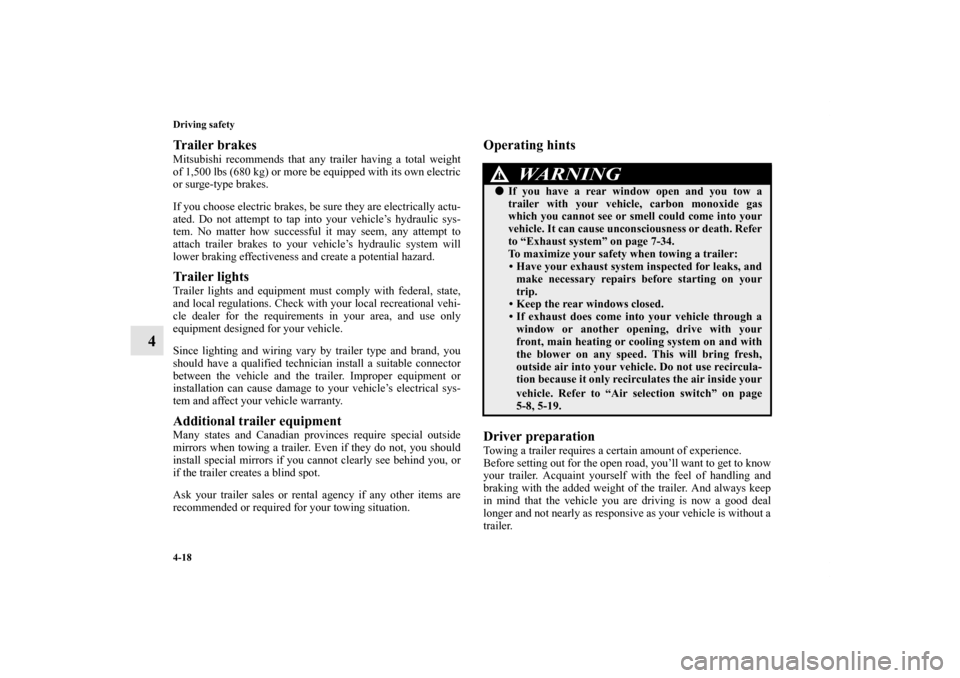Page 52 of 514

Seat and restraint systems
2-23
2 Seat belt pre-tensioner and force limiter
systems
N00417700524
The driver’s and front passenger’s seats each have a seat belt
equipped with a pre-tensioner system.Pre-tensioner system The driver and front passenger seat belts are equipped with a
seat belt pre-tensioner system. In moderate-to-severe frontal
collisions or when a rollover or overturning of the vehicle is
detected, the pre-tensioner system operates simultaneously
with the deployment of the front air bags or curtain air bags.
The seat belt pre-tensioners are located within the seat belt
retractors (A). When activated, the pre-tensioners quickly draw
back seat belt webbing and increase seat belt performance.The seat belt pre-tensioner system includes the following com-
ponents:
The air bag control unit monitors the readiness of the electronic
parts of the system whenever the ignition switch is in the “ON”
or “START” position. These include all of the items listed
above and all related wiring.
The pre-tensioner seat belts will operate only when the ignition
switch is in the “ON” or “START” position.
1- SRS warning light
2- Front impact sensors
3- Seat belt pre-tensioners
4- Seat belt buckle switches
5- Air bag control unit
BK0102600US.book 23 ページ 2009年3月30日 月曜日 午後2時2分
Page 68 of 514
Seat and restraint systems
2-39
2
How the Supplement Restraint System works
N00407800346
The SRS includes the following components:
The air bag control unit monitors the readiness of the electronic
parts of the system whenever the ignition switch is in the “ON”
or “START” position. These include all of the items listed
above and all related wiring.
The air bags will operate only when the ignition switch is in the
“ON” or “START” position. 1- Driver’s air bag
2- SRS warning light
3- Passenger’s air bag off indicator
4- Passenger’s front air bag
5- Front impact sensors
6- Driver’s seat position sensor
7- Passenger’s seat weight sensors
8- Air bag control unit
9- Side air bag modules
10- Curtain air bag modules
11- Side impact sensors
BK0102600US.book 39 ページ 2009年3月30日 月曜日 午後2時2分
Page 87 of 514

2-58 Seat and restraint systems
2
SRS servicing
N00408500643
NOTE�When you transfer ownership of the vehicle to another
person, we urge you to alert the new owner that it is
equipped with the SRS and refer that owner to the applica-
ble sections in this owner’s manual.
�If you decide to junk or scrap your vehicle, we urge you to
first take it to an authorized Mitsubishi Motors dealer so
that the SRS can be made safe for disposal.
WA R N I N G
!�Any maintenance performed on or near the compo-
nents of the SRS should be performed only by an
authorized Mitsubishi Motors dealer. Do not permit
anyone else to do any service, inspection, mainte-
nance or repair on any SRS components or wiring.
Similarly, no part of the SRS should ever be han-
dled, removed or disposed by anyone except an
authorized Mitsubishi Motors dealer.
Improper work methods on the SRS components or
wiring could result in an accidental air bag deploy-
ment or could make the SRS inoperable. Either of
these situations could result in serious injury or
death.�Do not modify your steering wheel or any other SRS
component or related vehicle part. For example,
replacement of the steering wheel, or modifications
to the front bumper or body structure can adversely
affect SRS performance and may lead to injury.�If your vehicle has received any damage, you should
have the SRS inspected by an authorized Mitsubishi
Motors dealer to make sure it is in proper working
order. �Do not modify your front seats, center pillar or cen-
ter console. Such modifications can adversely affect
SRS performance and may lead to injury.
Also, if you discover any tear or open seam in the
seat fabric near the side air bag, have the seat
inspected by an authorized Mitsubishi Motors
dealer.
�If you find a crack in or damage to the front pillar,
rear pillar, or roof side rail where the curtain air bag
is located, have the SRS inspected by an authorized
Mitsubishi Motors dealer.
WA R N I N G
!
BK0102600US.book 58 ページ 2009年3月30日 月曜日 午後2時2分
Page 317 of 514

4-18 Driving safety
4
Trailer brakesMitsubishi recommends that any trailer having a total weight
of 1,500 lbs (680 kg) or more be equipped with its own electric
or surge-type brakes.
If you choose electric brakes, be sure they are electrically actu-
ated. Do not attempt to tap into your vehicle’s hydraulic sys-
tem. No matter how successful it may seem, any attempt to
attach trailer brakes to your vehicle’s hydraulic system will
lower braking effectiveness and create a potential hazard.Trailer lightsTrailer lights and equipment must comply with federal, state,
and local regulations. Check with your local recreational vehi-
cle dealer for the requirements in your area, and use only
equipment designed for your vehicle.
Since lighting and wiring vary by trailer type and brand, you
should have a qualified technician install a suitable connector
between the vehicle and the trailer. Improper equipment or
installation can cause damage to your vehicle’s electrical sys-
tem and affect your vehicle warranty.Additional trailer equipmentMany states and Canadian provinces require special outside
mirrors when towing a trailer. Even if they do not, you should
install special mirrors if you cannot clearly see behind you, or
if the trailer creates a blind spot.
Ask your trailer sales or rental agency if any other items are
recommended or required for your towing situation.
Operating hints
Driver preparationTowing a trailer requires a certain amount of experience.
Before setting out for the open road, you’ll want to get to know
your trailer. Acquaint yourself with the feel of handling and
braking with the added weight of the trailer. And always keep
in mind that the vehicle you are driving is now a good deal
longer and not nearly as responsive as your vehicle is without a
trailer.
WA R N I N G
!�If you have a rear window open and you tow a
trailer with your vehicle, carbon monoxide gas
which you cannot see or smell could come into your
vehicle. It can cause unconsciousness or death. Refer
to “Exhaust system” on page 7-34.
To maximize your safety when towing a trailer:
• Have your exhaust system inspected for leaks, and
make necessary repairs before starting on your
trip.
• Keep the rear windows closed.
• If exhaust does come into your vehicle through a
window or another opening, drive with your
front, main heating or cooling system on and with
the blower on any speed. This will bring fresh,
outside air into your vehicle. Do not use recircula-
tion because it only recirculates the air inside your
vehicle. Refer to “Air selection switch” on page
5-8, 5-19.
BK0102600US.book 18 ページ 2009年3月30日 月曜日 午後2時2分
Page 470 of 514
Vehicle care and maintenance
7-43
7
5. Use the fuse location diagrams and the matching tables, to
check the fuse that is related to the problem. If the fuse is
not blown, something else must be causing the problem.
Contact an authorized Mitsubishi Motors dealer or a
repair facility of your choice to have the problem checked.6. Insert a new fuse of the same capacity securely into the
appropriate slot. A- Fuse is OK
B- Blown fuse
CAUTION
!�Never use a fuse with a capacity greater than the one
listed or any substitute, such as wire, foil etc. This
would cause the circuit wiring to heat up and could
cause a fire. �If the replacement fuse blows again after a short
time, have the electrical system checked by an
authorized Mitsubishi Motors dealer or a repair
facility of your choice to find and correct the cause.
BK0102600US.book 43 ページ 2009年3月30日 月曜日 午後2時2分